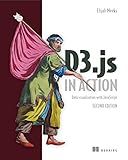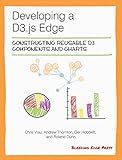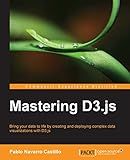Best Tools for D3.js Selection to Buy in December 2025

D3.js in Action, Third Edition



D3.js in Action: Data visualization with JavaScript



Interactive Data Visualization for the Web: An Introduction to Designing with D3



Developing a D3.js Edge



Mastering D3.js - Data Visualization for JavaScript Developers


In D3.js, you can select the last child element using the ":last-child" selector. This selector targets the last child element of its parent.
To select the last child using D3.js, you can use the ".select()" function followed by the ":last-child" selector. Here's an example:
d3.select("parentElementSelector") .select(":last-child") .style("color", "red");
In the code snippet above, replace "parentElementSelector" with the appropriate CSS selector for the parent element of the last child you want to select. Then, the ".select()" function is used to select that parent element. Finally, the ":last-child" selector is appended to select the last child of the parent element. You can perform any action on the selected element, such as changing its style or attributes.
Remember to include the D3.js library before using these functions. You can include D3.js using a script tag in your HTML file or via a module bundler like Webpack or Rollup.
How to apply the :last-child selector in d3.js?
In d3.js, we can use the :last-child CSS pseudo-class selector by appending it to the class name or element name when selecting elements. Here's an example:
// Select all div elements that are the last child of their parent d3.selectAll("div:last-child") .style("color", "red");
In the above code snippet, d3.selectAll("div:last-child") selects all div elements that are the last child of their parent. Then, the .style("color", "red") method sets the color of those elements to red.
You can also use the :last-child selector with a class name:
// Select all elements with class "item" that are the last child of their parent d3.selectAll(".item:last-child") .style("color", "blue");
In this example, d3.selectAll(".item:last-child") selects all elements with class "item" that are the last child of their parent. The .style("color", "blue") method sets the color of those elements to blue.
How to modify the style or attributes of the last child element using d3.js?
To modify the style or attributes of the last child element using d3.js, you can follow these steps:
- Select the parent element containing the child elements using a suitable selector. var parent = d3.select("#parentElement");
- Select the last child element of the parent. var lastChild = parent.select(":last-child");
- Modify the style or attributes of the last child element using the .style() or .attr() methods. lastChild.style("color", "red") .attr("class", "modified-class"); Here, we are modifying the color style to "red" and adding a new class attribute to the last child element.
- If you want to modify multiple styles or attributes, you can chain the .style() or .attr() methods. lastChild.style("color", "red") .style("background-color", "yellow") .attr("class", "modified-class") .attr("data-value", "10"); This example modifies the color style, background-color style, class attribute, and data-value attribute of the last child element.
Remember to replace #parentElement with the appropriate selector for your parent element.
What other CSS pseudo-classes can be combined with the :last-child selector in d3.js?
In d3.js, you can combine the :last-child pseudo-class selector with various other CSS selectors to target specific elements. Some common selectors that can be combined with :last-child in d3.js include:
- :nth-child(n) - This selector selects every element that is the nth child of its parent. For example, you can use :nth-child(2) to select the second child element of its parent.
- :first-child - This selector selects an element if it is the first child of its parent.
- :nth-last-child(n) - This selector selects every element that is the nth child, counting from the last child. For example, :nth-last-child(2) selects the second-to-last child of its parent.
- :only-child - This selector selects an element if it is the only child of its parent.
- :not(selector) - This selector matches elements that do not match the given selector.
These pseudo-classes can be combined with :last-child to further refine element selection in d3.js. For example, you can use :last-child:nth-child(2) to select the second-to-last child of its parent, or :last-child:not(p) to select the last child that is not a <p> element.
How to select the last child element based on its text content in d3.js?
To select the last child element based on its text content in d3.js, you can use the :last-child selector in combination with the .filter() function. Here's an example:
// Select the last child element that contains the text "example" var lastElement = d3.selectAll("span:last-child") .filter(function() { return d3.select(this).text() === "example"; });
// Manipulate the selected element lastElement.style("color", "red");
In this example, d3.selectAll("span:last-child") selects all the last child span elements. The .filter() function is then used to filter the selection based on the text content of each element. The .text() function is used to retrieve the text content of each element, and the === operator is used to compare it with the desired text value. Finally, you can manipulate the selected last child element using any d3.js method or function, such as .style() in the example above.
